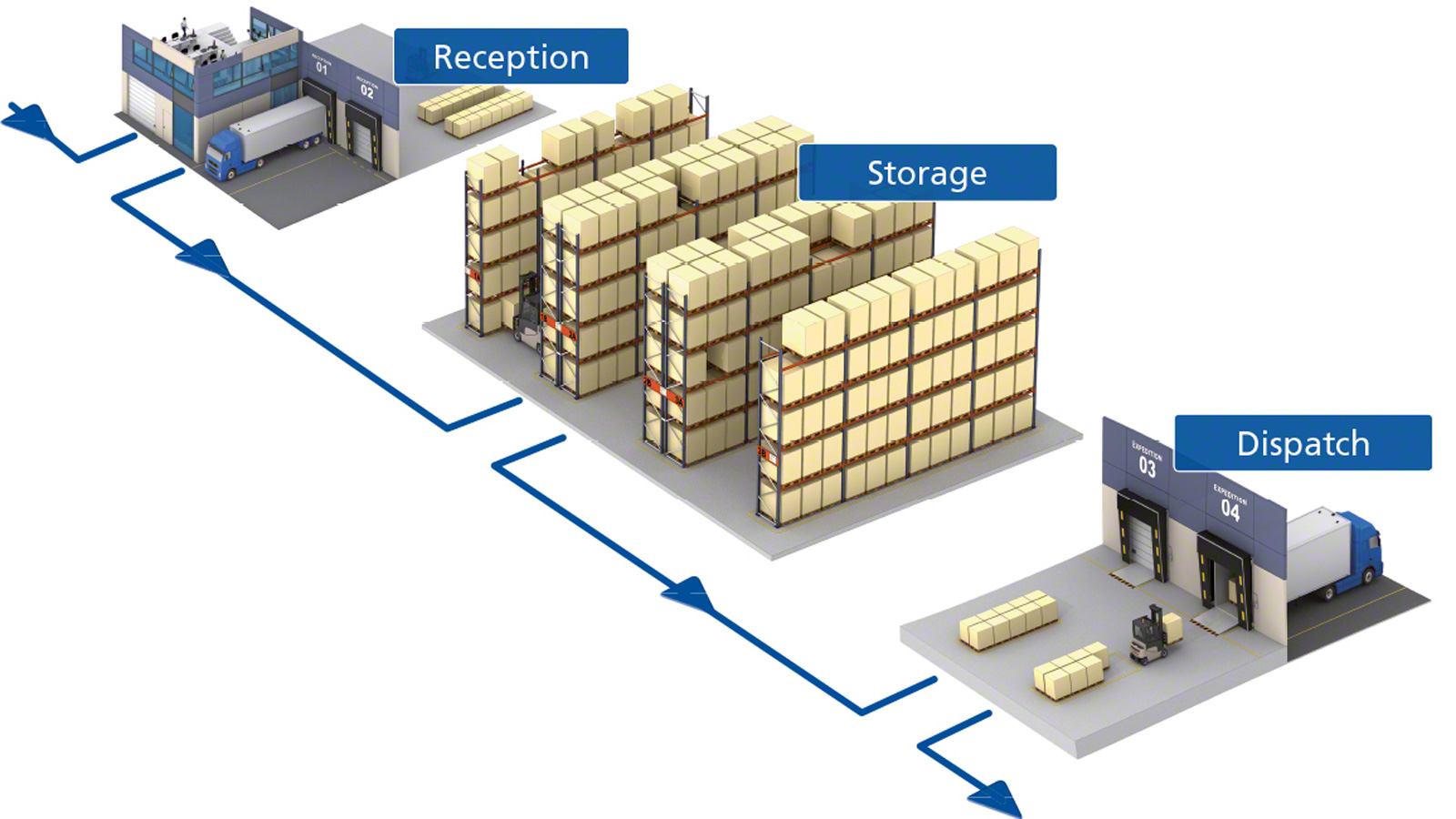An effective Warehouse Manager should:
![]() Manage warehouse in compliance with company’s policies and vision
Manage warehouse in compliance with company’s policies and vision![]() Oversee distribution and maintenance operations
Oversee distribution and maintenance operations![]() Setting up layout and ensure efficient space utilization
Setting up layout and ensure efficient space utilization
![]() Direct receiving, warehousing and distribution operations.
Direct receiving, warehousing and distribution operations. ![]() Oversee the efficient receipt, storage, value-adding servicing and dispatch of a wide variety of products.
Oversee the efficient receipt, storage, value-adding servicing and dispatch of a wide variety of products.![]() Ensure productivity targets are achieved and that all warehouse processes are running smoothly and promptly.
Ensure productivity targets are achieved and that all warehouse processes are running smoothly and promptly.
Responsibilities![]() Strategically manage warehouse in compliance with company’s policies and vision
Strategically manage warehouse in compliance with company’s policies and vision![]() Oversee receiving, warehousing, distribution and maintenance operations
Oversee receiving, warehousing, distribution and maintenance operations![]() Setup layout and ensure efficient space utilization
Setup layout and ensure efficient space utilization![]() Initiate, coordinate and enforce optimal operational policies and procedures
Initiate, coordinate and enforce optimal operational policies and procedures![]() Adhere to all warehousing, handling and shipping legislation requirements
Adhere to all warehousing, handling and shipping legislation requirements![]() Maintain standards of health and safety, hygiene and security
Maintain standards of health and safety, hygiene and security![]() Manage stock control and reconcile with data storage system
Manage stock control and reconcile with data storage system![]() Prepare annual budget
Prepare annual budget![]() Liaise with clients, suppliers and transport companies
Liaise with clients, suppliers and transport companies![]() Plan work rotates , assign tasks appropriately and appraise results
Plan work rotates , assign tasks appropriately and appraise results![]() Recruit, select, orient, coach and motivate employees
Recruit, select, orient, coach and motivate employees![]() Produce reports and statistics regularly (IN/OUT status report, dead stock report )
Produce reports and statistics regularly (IN/OUT status report, dead stock report )![]() Receive feedback and monitor the quality of services provided
Receive feedback and monitor the quality of services provided
Certified Warehouse Manager Body of knowledge
Role of a Warehouse![]() Benefits of Warehousing
Benefits of Warehousing![]() Functions of Warehouses
Functions of Warehouses![]() Need for Holding Stock
Need for Holding Stock![]() Characteristics of Warehouses
Characteristics of Warehouses![]() Warehousing Efficiency and Effectiveness
Warehousing Efficiency and Effectiveness![]() Information and Technology Requirements
Information and Technology Requirements![]() Measuring Performance
Measuring Performance
Role of Warehouse Manager![]() Challenges for Warehouse Managers
Challenges for Warehouse Managers![]() Attracting and Retaining Warehouse Employees
Attracting and Retaining Warehouse Employees![]() Ageing and Constantly Changing Workforce
Ageing and Constantly Changing Workforce![]() Employee Training
Employee Training
Warehouse processes![]() Receiving
Receiving![]() Pre-receipt
Pre-receipt![]() In-handling
In-handling![]() Preparation
Preparation![]() Offloading
Offloading![]() Checking
Checking![]() Cross Docking
Cross Docking![]() Recording
Recording![]() Quality control
Quality control![]() Put-away
Put-away
Warehouse Operating Principles![]() Warehouse Design
Warehouse Design![]() Types of Warehouses
Types of Warehouses![]() Warehouse Location
Warehouse Location![]() Planning the Distribution Warehouse
Planning the Distribution Warehouse![]() Warehouse Layout
Warehouse Layout![]() Qualitative Factor Rating Method
Qualitative Factor Rating Method
Picking Strategies and
![]() Picker to Goods
Picker to Goods![]() Goods to Picker
Goods to Picker![]() Automated Picking
Automated Picking![]() Material Handling Equipment
Material Handling Equipment![]() Storage Equipment
Storage Equipment
Order picking methods![]() Industry Trends Affecting Order Picking
Industry Trends Affecting Order Picking![]() Modern Order Picking Systems
Modern Order Picking Systems![]() Stock Profiling
Stock Profiling![]() Order Picking Alternatives
Order Picking Alternatives![]() Order Picking Strategies
Order Picking Strategies![]() Pick-To-Light Systems
Pick-To-Light Systems![]() Paper Pick Lists
Paper Pick Lists![]() Pick by Label
Pick by Label![]() Pick by Voice
Pick by Voice![]() Barcode Scanning
Barcode Scanning![]() Radio Frequency Identification
Radio Frequency Identification![]() Pick by Light/Pick to Light
Pick by Light/Pick to Light![]() Put to Light
Put to Light![]() Type of Picking System and Equipment
Type of Picking System and Equipment
Warehouse processes from Replenishment to Dispatch![]() Replenishment
Replenishment![]() Value Adding Services
Value Adding Services![]() Stock Management
Stock Management![]() Stock or Inventory counting
Stock or Inventory counting![]() The Annual count
The Annual count![]() Security
Security![]() Returns Processing
Returns Processing![]() Dispatch
Dispatch![]() Role of Driver in Transportation
Role of Driver in Transportation
Warehouse Management System![]() WMS Requirement
WMS Requirement![]() Other Functionality/Considerations
Other Functionality/Considerations![]() Why does a company need a WMS?
Why does a company need a WMS?![]() Advantages of WMS
Advantages of WMS![]() Choosing a WMS
Choosing a WMS![]() Selection Process
Selection Process![]() Software as a service
Software as a service
Warehouse Layout and Design![]() Requirement for a Redesign
Requirement for a Redesign![]() Design Approach
Design Approach![]() Warehouse Design
Warehouse Design
Storage and Handling equipment![]() Storage Systems
Storage Systems![]() Pallets
Pallets![]() Automated storage and retrieval Systems (AS/RS)
Automated storage and retrieval Systems (AS/RS)![]() Temperature-Controlled Storage
Temperature-Controlled Storage![]() Storage of Packaged Dangerous Substances
Storage of Packaged Dangerous Substances
Warehouse costs![]() Types of costs
Types of costs![]() Return on investment (ROI)
Return on investment (ROI)![]() Traditional versus Activity Based Costing Systems
Traditional versus Activity Based Costing Systems![]() Activity based Costing for Multi-Principals
Activity based Costing for Multi-Principals![]() Calculating Warehouse Storage Costs
Calculating Warehouse Storage Costs![]() Logistics Charging Methods
Logistics Charging Methods
Outsourcing![]() Why should one outsource?
Why should one outsource?![]() Outsourcing Decision
Outsourcing Decision![]() Role of Third Party Contractors
Role of Third Party Contractors![]() Choosing the Right Partner
Choosing the Right Partner![]() Managing Third Party Relationship
Managing Third Party Relationship![]() Why contracts with third party fail?
Why contracts with third party fail?![]() Future of Outsourcing
Future of Outsourcing
Warehouse and the environment![]() Environmental Effects
Environmental Effects![]() Environmental Impact Assessment Tool
Environmental Impact Assessment Tool![]() The Environment Model
The Environment Model![]() Flow chart of Green Logistics
Flow chart of Green Logistics![]() Steps to for Improvement
Steps to for Improvement

